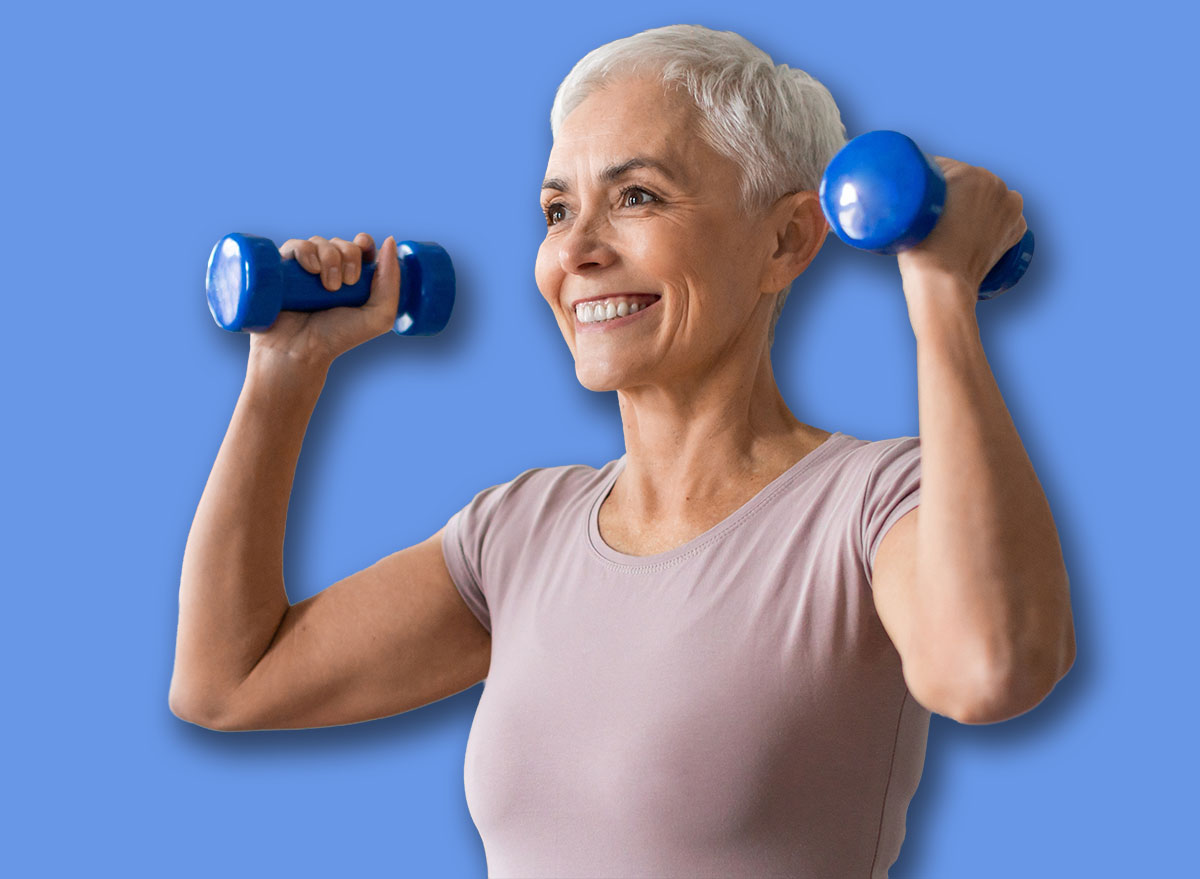This 7-Minute Standing Routine Strengthens Arms Better Than Weight Machines After 50

Weight machines are like a group of old, familiar friends at the gym. Each one targets a different muscle, and you can steadily progress to build strength and mass. Alternately, a standing routine can be more beneficial for improving functional strength and balance when combined with free weights, as you’ll fire up a greater number of stabilizing muscles. If you’re ready for a fresh and new standing workout, we have one that takes just seven minutes and will strengthen your arms better than weight machines after 50.
“A short, standing arm workout can efficiently build upper-body and core strength with less distraction, less need for specialized equipment, and more focus on the actual work of what it is you are trying to accomplish while providing ample benefit for full body health,” explains Michelle Ditto, VP of training and technique for Pure Barre. “Specifically in those over 50, standing exercises can prove more accessible, as you can typically focus on the movements themselves rather than having to figure out how to use equipment or get into/out of a machine. Importantly, a typical machine-based workouts can be as effective as standing free weight (or body weight) workouts; but taking into consideration the other needs of machine-based routines is key to establish whether a specific workout or exercise is the best one for you.”
For those 50+, it’s crucial to maintain strong postural muscles. Prioritizing core engagement and proper spinal alignment is essential to achieving better balance and mobility—both key aspects of healthy aging.
7-Minute Standing Arm Workout That Beats Machines After 50

Below, Ditto breaks down a speedy arm workout that offers holistic upper-body strength and core activation.
“The below can be performed with light weights (anywhere from 2-5 lbs), moderate weights (5+ lbs), a resistance band, or without weight (body weight only),” she explains. “Important: as needed, take a 15 to 30 second break between each set. For a higher intensity endurance upper body workout, aim to keep working through the full 7 minutes!”
Standing Overhead Press (1.5 Minutes)
“This movement targets the full range of motion in the shoulder joint, the most mobile joint in the body,” Ditto tells us. “With a lot of muscles supporting the shoulder girdle, it is important to fully explore the range of motion of this joint to allow access to the stabilizer muscles. Ignoring mobility work can leave strength (and gains) on the table. This is where the full scope of your strength can start from—mobility work!”
- Stand tall with your feet hip-width apart, toes pointing forward, and elbows bent at your sides.
- Soften your knees and brace your core.
- Press your arms overhead, and then pull them down to form a 90-degree bend.
- Repeat for 30 seconds.
- Then, speed the exercise up for 15 seconds.
- Next, hold your elbows at your sides. Slide your forearms closed (parallel) then open (palms facing forward).
- Repeat for 30 seconds.
- Finally, hold your forearms parallel and pull your elbows back in a tiny range of motion, replicating small pulses.
- Do this for 15 seconds.
Bicep Curls (2 Minutes)
“Performing both bilateral and unilateral variations provides unique benefits for your core and the biceps themselves. Bilateral work = both sides of the body working together. Unilateral work = one side of the body moving at a time,” Ditto explains. “Bilateral movements are typically easier to perform, whereas unilateral movements challenge your balance and coordination, among other things.”
- Stand tall with your feet hip-width apart and arms extended ahead of you, holding a light weight in each hand.
- Slowly curl the weights up to your shoulders.
- Extend your arms back down, maintaining tension in the biceps.
- Repeat for 30 seconds.
- Then, curl one dumbbell up at a time.
- Repeat for 30 seconds.
- Repeat both of the above moves with your palms facing inward (hammer curls).
Chest / Back Flys (1.5 Minutes)
“Standing chest work is a great way to not only engage your pectoralis muscles but also to enhance core strength. Once you hinge into a bent over position, you challenge your core strength in a different way, while providing some reprieve to the upper body,” Ditto tells us. “Working both chest and back muscles in sequence provides equal and opposite work to the body, allowing you to enhance total body benefits in a balanced way.”
- Stand tall, feet hip-width apart, holding a dumbbell in each hand.
- Begin to make big circles with your arms, pressing the heads of the weights together.
- Slowly open your arms and close them together.
- Repeat the movement for 30 seconds.
- Speed the exercise up for 15 seconds.
- Hinge at the hips, maintaining a flat back and keeping your arms in the circle shape and soft knees.
- Gradually open your arms out wide then close them together.
- Do this for 15 seconds.
- Perform the same range of motion but with one arm at a time.
- Repeat for 30 seconds.
Triceps (1 Minute)
“Your triceps are the large muscle group on the back of your arms, and you target them here in different ways. Tricep kickbacks and overhead tricep extension allow you to focus on the full range of motion for the triceps while maintaining control and support of the core,” Ditto notes. “By performing isometric exercises, i.e., small range pulses, you target these muscles in a unique way to build endurance and enhance neuromuscular control.”
- Remain hinged in a bent-over position, keeping your back flat.
- Bend your elbows at your sides to form 90-degree angles with your palms facing inward.
- Slowly extend your arms behind you, keeping them aligned with the hips, then bend your elbows back in.
- Repeat for 15 seconds.
- Hold your arms straight and lift them in small pulses.
- Do this for 15 seconds.
- Then, stand up tall and reach both arms overhead, pressing the weights together.
- Bend your elbows as you lower the weights behind your head, keeping your elbows close to the sides of your head.
- Extend your arms back up.
- Do this for 15 seconds.
- Finally, bend your elbows and press your arms up in tiny pulses.
- Do this for 15 seconds.
Shoulders (1 Minute)
“Your shoulders have been engaged a lot through this standing workout, and finishing with them can feel like a mental push. This is a good thing, and can provide not only physical, but mental benefit as well,” Ditto explains. “Similar to how you started, these movements employ different ranges of motion for the shoulder girdle, while providing increased benefit for a different part of the shoulders by keeping the arms elevated throughout.”
- Stand tall, feet hip-width apart.
- Bend your elbows to form a goalpost position, elbows lined up with your shoulders.
- Press both arms overhead.
- Then, pull them back down to the goalpost position.
- Do this for 30 seconds.
- Next, hold your arms in the goalpost.
- Close your arms in front of you.
- Open them back up to a goalpost.
- Do this for 15 seconds.
- Finally, hold your arms parallel to each other, then press them up in tiny pulses.
- Do this for 15 seconds.